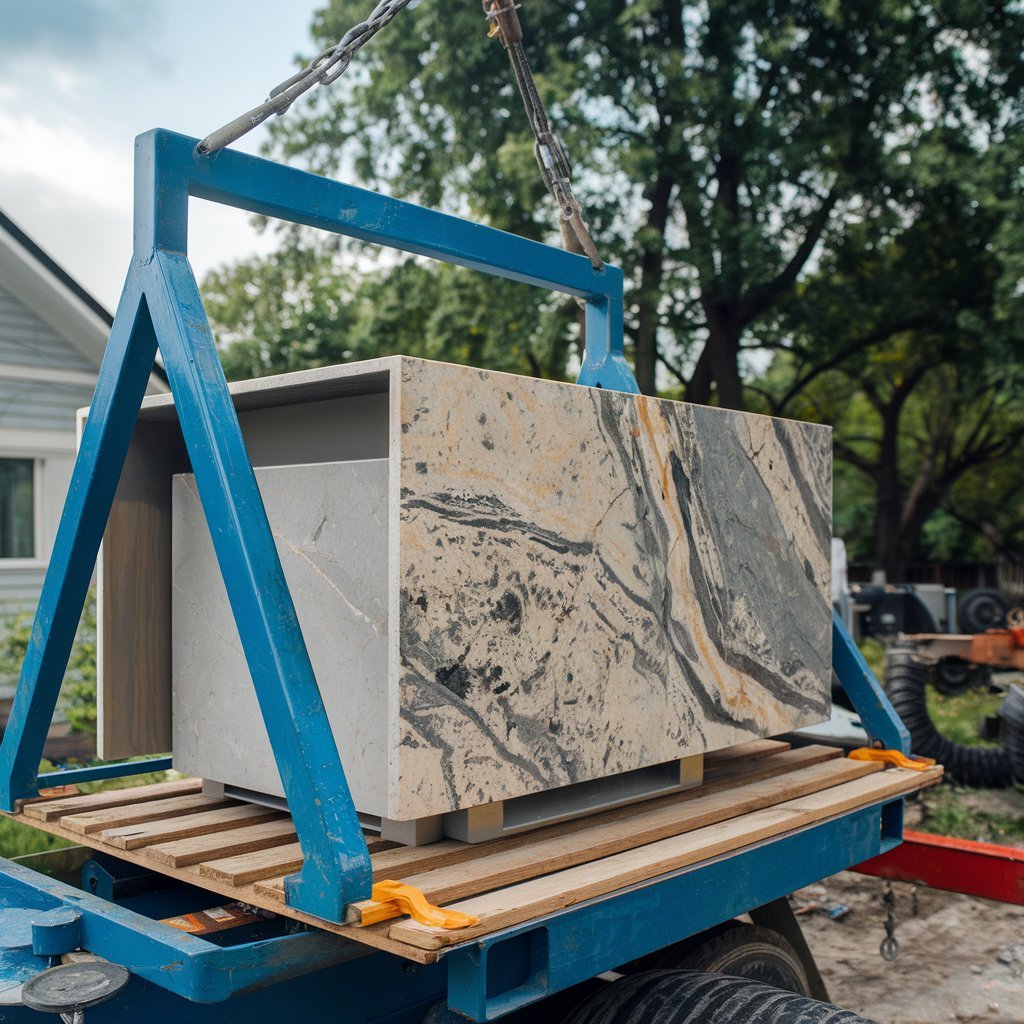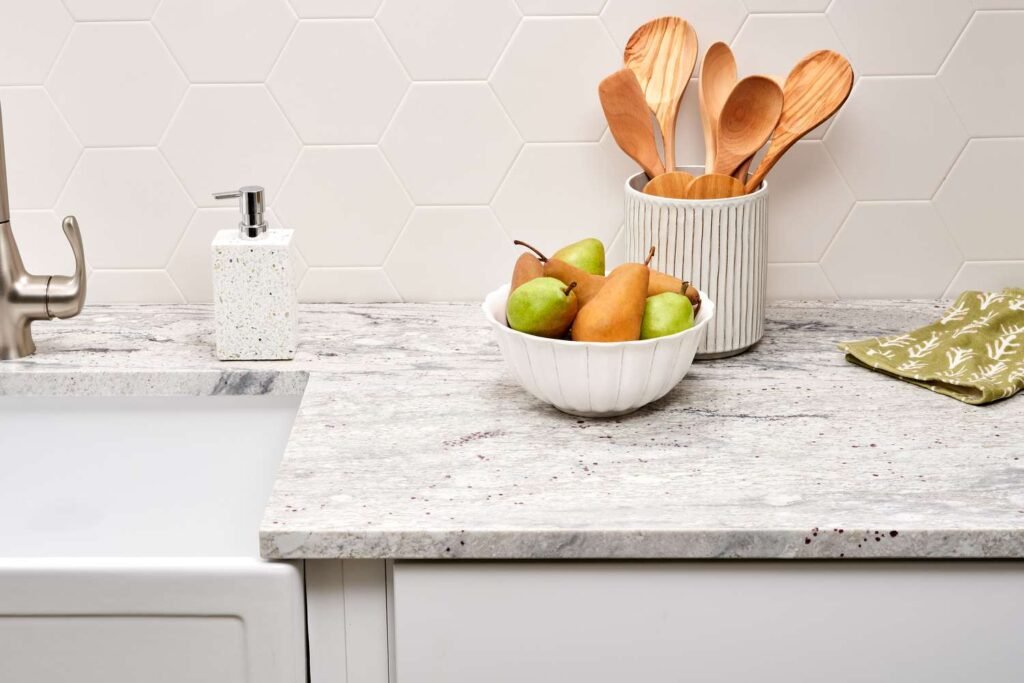A Timeless Fusion of Luxury and Durability
When it comes to high-end interior design, granite and marble stand as two of the most revered and sought-after materials.
Both natural stones possess unique characteristics, making them suitable for a wide range of applications. Whether you’re designing a kitchen, bathroom, or any other space in your home, granite and marble offer the perfect combination of beauty, durability, and sophistication. In this article, we’ll dive into the design possibilities, benefits, and considerations of using granite and marble in your home, as well as explore key differences between the two.

What is Granite and Marble?
Before delving into their design potential, it’s essential to understand what granite and marble are, how they differ, and what makes them such desirable materials.
Granite: A Strong, Durable Stone
Granite is an igneous rock formed from the crystallization of magma deep within the Earth’s crust. The stone is primarily made up of quartz, feldspar, and mica, which give it its unique grainy texture. Granite is extremely durable, making it ideal for high-traffic areas such as kitchens, bathrooms, and even outdoor spaces.
Granite comes in a wide variety of colors and patterns, from light and neutral shades like whites and creams to deep, rich tones like blacks, blues, and reds. The patterns in granite can range from fine speckles to large, bold veins, giving it versatility in design applications.
Marble: A Luxurious, Elegant Stone
Marble is a metamorphic rock formed from limestone that has been subjected to intense heat and pressure. It is primarily composed of calcite, which gives marble its distinctive soft veining and smooth texture. Marble is known for its luxurious and sophisticated aesthetic, often associated with high-end designs and classic elegance.
Marble is typically lighter in color, with hues of white, beige, and gray being common. The veins running through marble can be subtle or dramatic, depending on the specific variety. It is a preferred material for countertops, flooring, wall coverings, and sculptures due to its polished, glossy surface and timeless appeal.
Key Differences Between Granite and Marble
While both granite and marble are natural stones, they differ in several ways, each making them suitable for different applications in design. Here are some of the most important differences between granite and marble:
1. Durability and Strength
- Granite: Known for its remarkable durability, granite is highly resistant to scratches, heat, and stains. It is a tough material, making it perfect for areas with heavy use, such as kitchen countertops and bathroom vanities.
- Marble: While marble is still durable, it is more porous than granite and can be more prone to scratching and staining. Its softer surface means it may require more care, especially in high-traffic areas like kitchens. However, its elegance and refined appearance make it an excellent choice for areas where beauty is paramount.
2. Aesthetic Appeal
- Granite: Granite is versatile, with a variety of color and pattern options to choose from. Its textures range from fine to bold, offering a more speckled or granular look that fits well in both traditional and modern designs.
- Marble: Marble is synonymous with luxury, with its smooth texture and elegant veining creating a sophisticated and timeless look. The veining in marble varies from subtle, delicate patterns to dramatic, bold lines, making it a standout feature in design.
3. Maintenance
- Granite: Granite is relatively low-maintenance. It is heat, stain, and scratch-resistant, but it should be sealed periodically to prevent liquid absorption and stains. Cleaning granite requires just mild soap and water.
- Marble: Marble is more delicate and requires more upkeep. It is prone to stains from acidic substances (like wine, vinegar, or lemon), and regular sealing is necessary to protect the surface. Because of its softer nature, it’s also more susceptible to scratches and chips.
Granite and Marble in Interior Design
Both granite and marble can be used to elevate the design of any space. Whether you’re aiming for a contemporary, minimalist design or a traditional, luxurious look, these stones can be incorporated in a variety of ways.

1. Granite in Kitchen Design
Granite is a top choice for kitchen countertops due to its durability and resistance to heat, scratches, and stains. It is particularly well-suited for food preparation areas because it won’t absorb liquids like other materials. Granite’s wide range of colors and patterns also allows for customization, so you can choose a slab that complements your kitchen’s design. From dark, rich hues to light, creamy shades, granite can add both elegance and practicality to your kitchen.
Granite’s versatility also makes it ideal for backsplashes, islands, and even flooring. When paired with stainless steel appliances or wood accents, granite creates a balance of sophistication and functionality in your kitchen.
2. Marble in Bathroom Design
Marble’s luxurious aesthetic makes it an ideal choice for bathrooms, where its elegant veining and smooth surface create a sense of opulence. Marble is commonly used for bathroom vanities, countertops, flooring, and shower surrounds. White and gray marble is a popular choice in bathrooms due to its calming and spa-like effect.
In addition to countertops and flooring, marble can be used to create dramatic feature walls or even for decorative accents like sinks and bathtubs. Its timeless beauty transforms any bathroom into a relaxing retreat.


3. Granite and Marble for Flooring
Both granite and marble are suitable for flooring, though each material offers different advantages:
- Granite Flooring: Durable and resistant to heavy traffic, granite is an excellent option for high-traffic areas like hallways, entryways, and living rooms. It is particularly well-suited for outdoor areas and patios due to its ability to withstand the elements.
- Marble Flooring: Marble floors exude elegance and refinement, making them ideal for formal areas such as foyers, living rooms, and dining rooms. While marble requires more maintenance than granite, its aesthetic beauty can transform a space into something spectacular.
4. Granite and Marble for Decorative Elements
Granite and marble are also used as decorative elements in home design. Both stones can be incorporated into architectural features like columns, countertops, and mantelpieces, or even used for sculptures, artwork, and decorative objects. Whether you choose the bold patterns of granite or the subtle elegance of marble, these stones are perfect for making a statement.
Frequently Asked Questions (FAQs)
1. Is granite more durable than marble?
Lorem ipsum dolor sit amet, consectetur adipiscing elit. Ut elit tellus, luctus nec ullamcorper mattis, pulvinar dapibus leo.
2. Can marble be used in kitchens?
While marble can be used in kitchens, it is more susceptible to stains and scratches compared to granite. It’s ideal for low-traffic areas, but if used in kitchens, it requires regular maintenance and sealing.
3. How do I care for granite and marble countertops?
Both granite and marble require regular cleaning with mild soap and water. Granite should be sealed every 1-2 years to prevent staining, while marble should be sealed more frequently and cleaned with products specifically designed for marble surfaces.
4. Can I use granite or marble outdoors?
Granite is an excellent choice for outdoor applications because of its resistance to weathering. Marble can be used outdoors, but its surface is more susceptible to staining and damage from harsh weather conditions.
Granite and marble are both exceptional materials that offer unique qualities for any design project. Whether you’re looking for the durability and versatility of granite or the luxury and elegance of marble, both stones can elevate the look and feel of any space. By understanding the differences, benefits, and design applications of granite and marble, you can make an informed decision that suits your needs and style.


